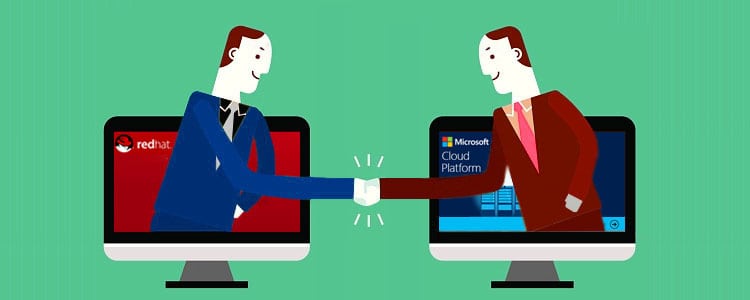
Microsoft Dons the Red Hat Over Growing Cloud Influence
Two rivals, Red Hat and Microsoft joined hands in early November 2015, described by Microsoft as possibly its deepest partnership with another major enterprise infrastructure provider is a great example of how companies are working together to make cloud computing easier, particularly hybrid cloud. Though Linux has been available on Microsoft Azure for some time now, this was the first time that Red Hat’s version of the Linux OS was being incorporated on the Microsoft’s cloud platform.
The new partnership has allowed customers to not only move their workloads between their data centers and the cloud and integrate cloud workloads with on-premises data, but they also can ensure that applications can take advantage of the best deployment architecture and technology platforms available in the market, according to Mike Ferris, senior director for business architecture at Red Hat.
Scott Guthrie, who heads Microsoft’s cloud platform stated that – Businesses continue to grapple with the challenge of bringing together existing on-premises investments with a cloud environment for greater speed, scale and cost benefits. Hybrid cloud has emerged as a way to solve this.
And now the customers are able to choose their operating systems and tools in cloud setups just as how they did in their on-premises data centers. This is also an opportunity for the developer community to build for and leverage both worlds.
What this means for the Red Hat customers
The collaboration brings unified workload management across hybrid cloud deployments so that Red Hat CloudForms would interoperate with Microsoft Azure and Microsoft System Center Virtual Machine Manager, offering Red Hat CloudForms customers, the ability to manage Red Hat Enterpise Linux (RHEL) on both Microsoft Azure and Hyper-V. Subscribers of Red Hat Cloud Access can thus, run their own VM images in Microsoft Azure.
Paul Cormier, Red Hat’s Products and Technologies president, wrote in a blog that the idea of proprietary software companies (Microsoft) embracing open source was hard for many to imagine. But modern data centers have become “heterogeneous environments that include solutions from both companies.” Cormier said Red Hat “heard from customers and partners that they wanted our solutions to work together – with consistent APIs, frameworks, management, and platforms.”
According to him, this is also about micro services running in containers. “Customers will want to be able to choose Microsoft Windows for Windows containers, and Red Hat Enterprise Linux Atomic Host and OpenShift for certified Red Hat Enterprise Linux containers unified by the common .NET framework,” he says.
What this means for the Microsoft Azure customers
For Azure customers, the partnership of the company with Red Hat means that they can access Red Hat’s application platform including Red Hat JBoss Enterprise Application Platform, JBoss Web Server, Gluster Storage and OpenShift- the company’s PaaS offering. The collaboration allows customers to use Azure as a preferred public cloud because it brings together the best elements of SaaS and IaaS for them.
Microsoft will provide access to .NET technologies across Red Hat’s OpenShift platform-as-a-service and RHEL in the weeks to come.
Microsoft’s strategic shift
Microsoft is offering RHEL as the preferred Linux choice on Microsoft Azure although it already has existing Linux offerings like Canonical’s Ubuntu, CentOS, CoreOS, Oracle Linux and SUSE Linux. In return, Microsoft Azure will become a Red Hat Certified Cloud and Service Provider.
Red Hat’s Enterprise Linux offering is the de facto Linux standard in business and with the new partnership move, Microsoft marks a significant renewal of its strategies in the midst of fierce competition from other public cloud titans like Amazon Web Services, Google Cloud and IBM Cloud.
So while for Red Hat customers it meant having the added convenience of being able to leverage one of the most robust and sophisticated cloud platforms in the world, for Microsoft, the partnership means much better ability to compete in the IaaS market.
In March 2016, Microsoft went on further increasing its investment in Linux and announced its plans to bring SQL Server to Linux as well. This will enable SQL Server to deliver a consistent data platform across Windows Server and Linux, as well as on-premises and cloud, according to the company.
SQL Server running on Linux also allows Microsoft to compete with Oracle whose databases have long supported Linux. As a free operating system, Linux helps enterprise customers save on data center costs and Microsoft can now address this segment of the market as well. This is the latest brilliant move by Microsoft and thanks to Satya Nadella, it’s cloud business is getting reformed, redefined and stronger than ever.
Check out our articles and infographics.
